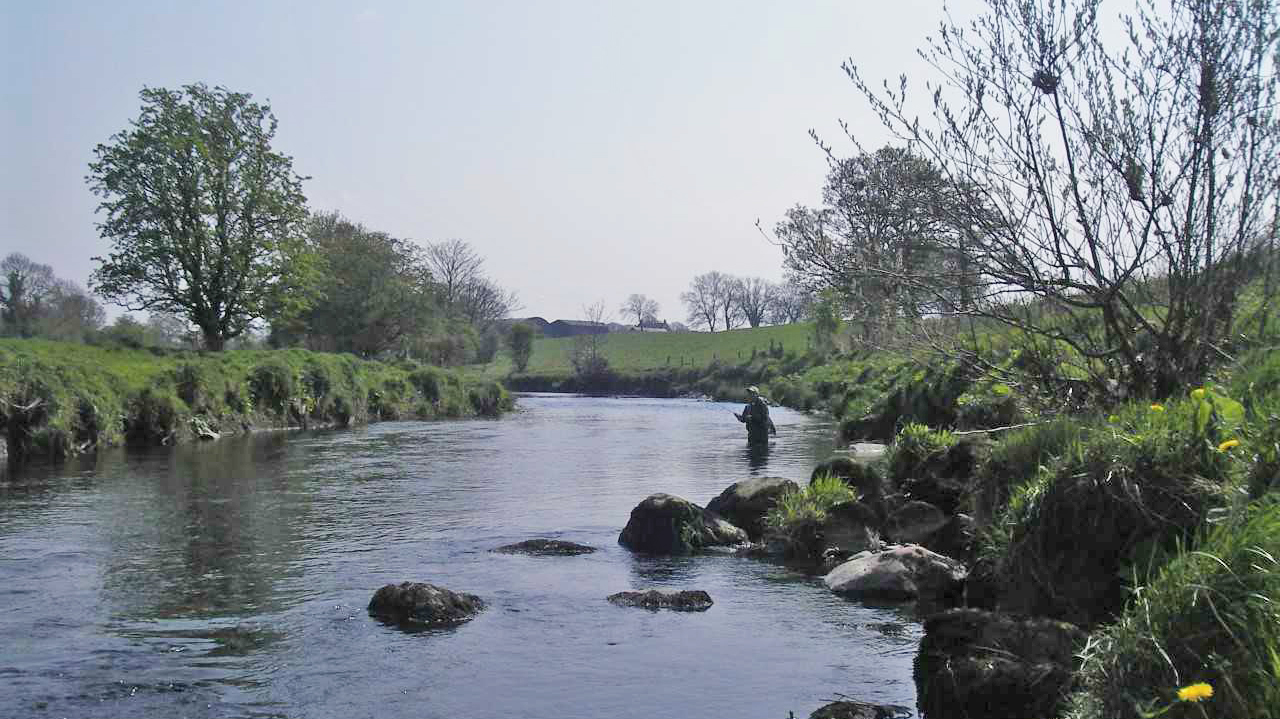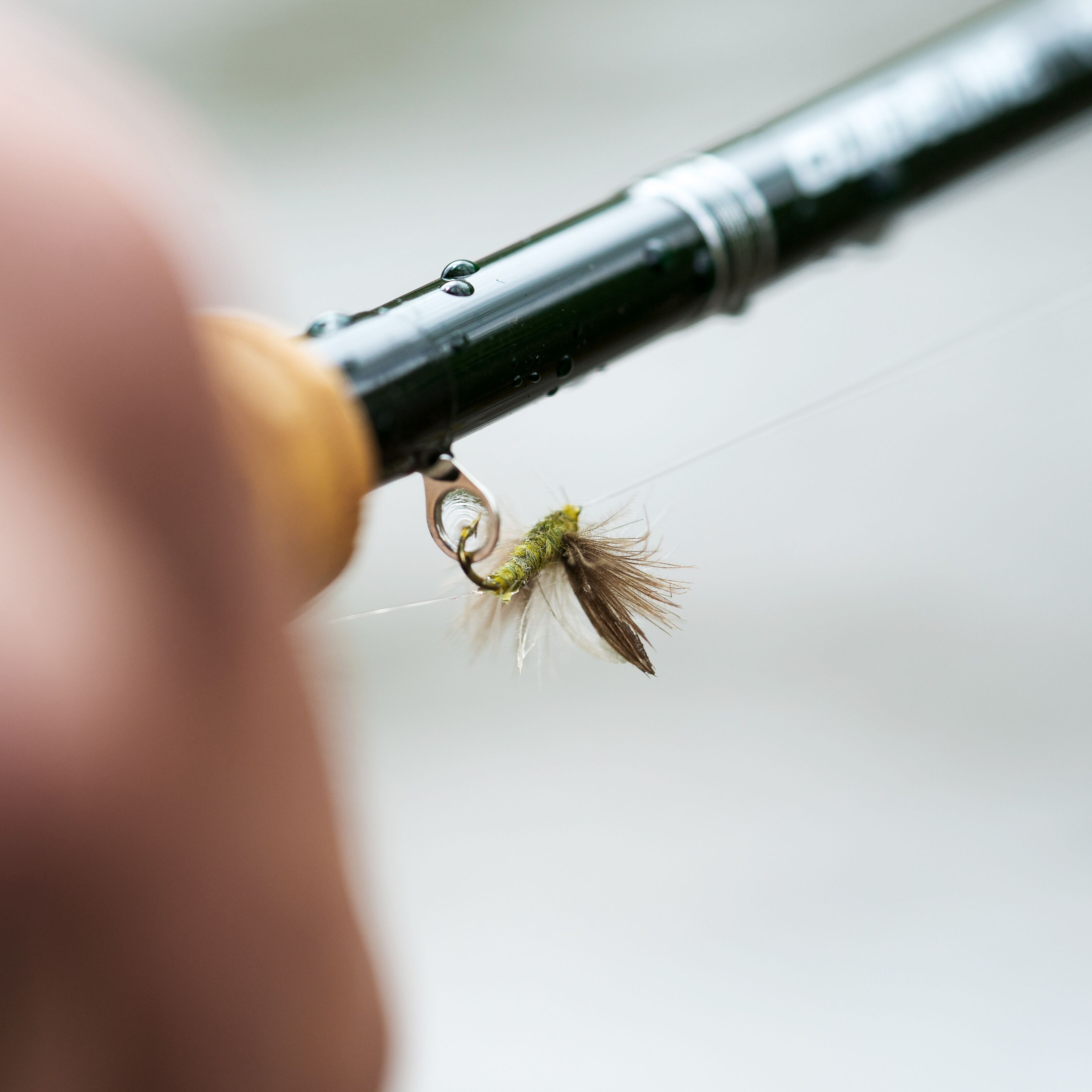
Early Season Fishing The Dark Olive - By Stevie Munn
At last my fishing season has begun, its March and the rain beats of my widow at the time of writing.
I have endured the long cold winter, whose monotony has only been broken by a few angling shows that I have worked at and my own Irish Fly fair which is amazing and into its tenth year. The shows fueled my appetite, making me want to go fishing even more but now once again I am out fishing for wild brown trout in my local streams and rivers and the world is good again.
The early part of the season is often hard but if you are very lucky you will get a hatch of Baetis rhodani, the Large Dark Olive (LDOs), and if this happens the sport for a few hours can be good. This is an insect of flowing water, and it can live in steep stony streams as well as in weed-rich chalk streams; the adults can be seen during the cold months of late Autumn, Winter and early spring, when few other flies are about.
Being there at the right time.
Try and time yourself to be on the river at the warmest part of the day.
I normally aim to get to the river about 11.30, as I know that my best time for a hatch which should be from 12 until about 2.30 maybe 3.30 on a milder day, this is on my local river the Sixmile Water in Co. Antrim in N.Ireland which I guide on. I sometimes call this ‘the trout’s opening hours’, so you would think that’s it, it’s easy just turn up at the right time and bingo you’re in.
One problem can be LDOs can at times be slightly unpredictable and often localised. So, the angler’s problem is do you stick with a place you know has worked in the past, hoping it’s going to happen? Or do you go looking on other stretches of the river, which can be time consuming in your short window, but there may be a hatch and trout are feeding on them?
Dark Olive Quill (Stevie Munn)
Silk. Nano Silk Copper
Hook. Partridge Dry Fly Supreme size 16-14
Tail. Fibre Fibbets Barred Olive
Body. Peacock Stripped Quill Olive.
Wing. CDC.
Hackle. Dark Olive. (sometimes I use natural red that works well on my local river)
Normally I try about three hot spots I know and hope that one of them pays dividends and if one is going okay, I stay there in that area and try to make the most of it.
The dry fly is my favourite way to fish this time of year, but if you don’t get a hatch of Large Dark Olive, it can be very hard and you may be better using the, wet fly, a streamer or probably even more productive, fishing with nymphs, depending on your water conditions of course. A good nymph for imitating LDOs is a Pheasant Tail Nymph.
Sometimes at this time of year you need to get down deep as the trout can be hard on the bottom this is when nymphing with heavy flies can produce and in the last few years tungsten-beaded flies have become a revelation getting you down to the fish, when they are not feeding on the top. These heavy flies in different sizes can work very well fished on a dead drift, in Czech or French nymphing style or in smaller rivers with less flow cast upstream and try and keep in touch with your fly line.
River Dry Fly Tactics
Let’s talk a little about some basic tactics and the dry fly on rivers. An artificial dry fly that copies or imitates something that the trout are feeding on is cast at rising fish, normally, but you can also use a dry fly to search the water for fish and often I do this casting at likely looking spots I know trying to make a trout rise. I am amazed how often I have brought up trout to a dry fly when no fish are rising. The best way to do this is to cover a lot of water, moving slowly upstream working the whole way up a stretch.
The fly is cast or presented to a fish in a way that the fish is unaware of the angler in the stream or any casting action he or she is making, we are trying to get our fly to behave like a natural food item or to give the impression to a fish that it is edible. The late American fly-fishing master Lefty Kreh, who I met a few years in the USA while working at an angling show, understood the importance of this with his excellent book, 'Presenting the Fly', which is well worth a read.
So, what does presenting a dry fly on a stream or river mean in real terms?
Well the first lesson to being successful is try to be very stealthy so not to scare or alert the fish. This may be achieved by casting to rising fish at long range or by using the correct light equipment. I love the excellent Guideline range of rods for my river fishing with a 9’ # 3, 4 or 5 or a versatile 9’9, 2 to 4 or a 10 # 3 being a great choice for the river angler in Ireland, or indeed if you fish small streams a smaller rod like 8‘or 8‘6‘’ maybe better.
Okay, back to being stealthy this will help you catch more, walk softly, fish are as sensitive to noise and vibration as they are to visual warnings. Walking lightly on the river banks and trying to wade slowly and quietly are very important tactics. Remember you are trying to fool a wild animal that you are not around. I recall when I was fishing with my father when I was very little, possibly as young as 7 or 8 years of age, he taught me a valuable lesson about being stealthy.
I was excitably running along the river bank while we were fishing, so he shouted at me telling me of, move slowly he shouted walk lightly, trout can hear. I thought he was mad trout don’t have ears I have seen them, I did not know back then about lateral lines, which is the sense organ fish use to detect movement and vibration in the surrounding water. Later that night while I was having a bath he came in pushed my head under the water and banged the side of the bath with his fist. Then let me up for air (thankfully) and said, trout hear and feel vibrations. I am not saying you half drown your children when teaching them to fish, but that lesson stuck in my head and it made me catch more trout. So be quiet and cast as light as you can. It the things that makes a good angler a great one with the dry or for that matter any sort of fly fishing.
Also, using camouflage or dull clothing to match the background.
Using a fly pattern that copies surface flies that fish are feeding on (matching the hatch anglers call it) or using an attractor dry fly to pull up a fish (usually when no hatch is apparent) by looking or behaving in a natural and enticing manner.
.jpg)
For good dry fly presentation it is often better if the tippet (the material usually a nylon/co-polymer/fluorocarbon onto which the fly is tied) sinks. However, the fly line and tapered leader should float, if not they would act to pull the dry fly under the surface. The dry fly must be cast and fished to copy the behaviour of natural insects. Many of these insects sit motionless on or in the surface film of the water and are carried naturally by the stream, to the trout. To copy or imitate these insects that are riding on the surface currents the angler must make at times, river presentation casts, these casts ensure there is enough slack in the line leader and tippet so the fly is not dragged back unnaturally.
Fly fishers therefore try and eliminate drag, caused mostly by the currents in the river and the fly line or leader and tippet dragging, we almost always aim for a drag free drift. The drift is the distance the fly travels downstream without dragging. When the presentation is good and the fly is drag free the trout will sometimes and I stress sometimes be fooled.
These casts are easily learnt and are made by mending your line by moving your rod tip. Here is a blatant plug ... anyone looking lessons for these and many other casts please email me, if I don’t live near I can give you a qualified instructor contact details - my email is listed at the bottom of the page.
Dry fly is one of the most enjoyable forms of fly fishing and perhaps still my favourite method, but probably more productive is early season nymphing.
There is nothing better than fishing the dry fly on a river watching trout rise to your fly its exciting, beautiful and visual what could be better when the cast the rise and the trout take what could be better?
Tight lines for 2019!
Very Best Regards,
Stevie Munn
Guideline Power Team
Irish Rep Costa Glasses & Semperfli.
MD Irish Fly Fair.
Consultant Angling Writer
Game Fly Casting Fly Tying Instructor and Pro Guide.
Serious Fishing Gear Recommendations:
Guideline Fario Classic Fly Rod
Guideline LPS Nymph Rod
Waterworks Lamson Liquid Pack (2 Spare Spool)
Fulling Mill Large Dark Olive
Fulling Mill Pheasant Tail Nymph
Scientific Anglers Mastery Trout
Tacky Dry Fly Box
Fulling Mill World Class Fluorocarbon
Simms Tributary Waders
Simms Guide Jacket
Simms Guide Mid Top
About Stevie Munn:
Guideline Power Team member and Game Angling Consultant Stevie Munn works full time as a fishing guide, writer and qualified game angling instructor in fly casting and fly tying, he has also appeared in many angling books, magazines and DVDs and gives casting demonstrations at angling events all over the world.
He has fished many places in the world and grew up fishing on rivers and loughs of Ireland where he often guides.
He runs teaching courses in Ireland and host groups to fish in Iceland, Norway, Argentina and other parts of the world.

You can contact him via email anglingclassics@aol.com and for more information visit www.anglingclassics.co.uk

.jpg)


.jpg)

